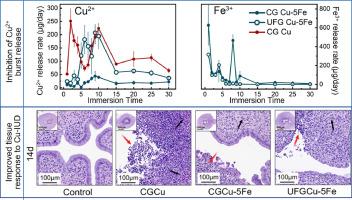使用高生物相容性铜-5Fe 合金减轻含铜宫内节育器的不良影响
IF 9.6
1区 医学
Q1 ENGINEERING, BIOMEDICAL
引用次数: 0
摘要
含铜宫内节育器(Cu-IUD)具有长期有效、可逆和经济实惠等优点,被全世界妇女广泛采用。然而,由于 Cu2+ 的猝发释放,Cu-IUD 在子宫内植入初期会出现不良反应。为了尽量减少迸发释放,本研究设计了一系列含铁量分别为 0.5 wt%、1 wt% 和 5 wt% 的铜铁合金,并通过等通道角压进一步制备了这些合金的超细晶粒(UFG)结构。我们系统地研究了粗晶粒(CG)铜合金、CG 铜铁合金和 UFG 铜铁合金的微观结构和性能,包括晶粒结构和相组成、金属离子释放行为、电化学腐蚀性能和体外细胞毒性。经过仔细比较和筛选,我们选择了 CG Cu-5Fe 和 UFG Cu-5Fe 进行大鼠模型体内试验,包括组织生物相容性、体内腐蚀行为和避孕效果。此外,还讨论了 Cu-5Fe 合金的腐蚀机理及其改善的生物相容性。在长期浸泡过程中,CG 和 UFG Cu-5Fe 合金都能显著抑制模拟子宫液中 Cu2+ 的释放。将 CG 和 UFG Cu-5Fe 合金植入大鼠子宫后,其体内组织相容性得到了明显改善,同时还保持了较高的避孕效果。由于具有良好的生物相容性,CG 和 UFG 铜-5Fe 合金有望成为铜宫内节育器的候选材料。重要意义:为含铜宫内节育器(Cu-IUD)设计并制造了一种高生物相容性的铜铁合金。在含 5wt% Fe 的情况下,由于 Cu 和 Fe 形成了电偶,Cu2+ 的猝发释放受到抑制,从而导致 Fe3+ 的提前释放。由于铁是人体最丰富的必需微量元素,它可以减轻 Cu2+ 的毒性效应,从而显著提高体外细胞相容性和体内组织相容性。更重要的是,Cu-5Fe 合金与 CG Cu 相比,避孕效率达到 100%,但对子宫组织的不良影响却大大降低。利用 Cu-Fe 合金可以开发出先进的 Cu-IUD 。本文章由计算机程序翻译,如有差异,请以英文原文为准。

Mitigating adverse effects of Cu-containing intrauterine devices using a highly biocompatible Cu5Fe alloy
Copper-containing intrauterine devices (Cu-IUD) are adopted by worldwide women for contraception with the advantages of long-term effectiveness, reversibility and affordability. However, adverse effects occur in the initial implantation stage of Cu-IUD in uterine because of the burst release of Cu2+. To minimize the burst release, in this study, we designed a series of Cu–Fe alloys with 0.5 wt%, 1 wt% and 5 wt% Fe and also further produced ultrafine grained (UFG) structure for these alloys via equal-channel angular pressing. The microstructures and properties of the coarse grained (CG) Cu, CG Cu–Fe alloys and UFG Cu–Fe alloys were systematically investigated, including grain structure and phase compositions, metallic ions release behavior, electrochemical corrosion performance, and in vitro cytotoxicity. With careful comparison and selection, we chose the CG Cu–5Fe and UFG Cu–5Fe for in vivo tests using rat model, including tissue biocompatibility, in vivo corrosion behavior, and contraceptive effectiveness. Moreover, the corrosion mechanism of the Cu–5Fe alloy and its improved biocompatibility was discussed. Both CG and UFG Cu–5Fe alloys exhibited dramatic suppression of Cu2+ release in simulated uterine fluid for the long-term immersion process. The in vivo tissue compatibility was significantly improved with both CG and UFG Cu–5Fe alloys implanted in the rats’ uterine while the high contraceptive efficacy was well maintained. Due to the superior biocompatibility, the CG and UFG Cu–5Fe alloys can be the promising candidate material for Cu-IUD.
Statement of significance
A highly biocompatible Cu–Fe alloy was designed and fabricated for Cu-containing intrauterine devices (Cu-IUD). With 5 wt% Fe, the burst release of Cu2+ is inhibited due to the formed galvanic cell of Cu and Fe, resulting in earlier release of Fe3+. As Fe is the most abundant essential trace element of human body, it can mitigate the toxic effects of Cu2+, thus significantly improving both in vitro cell compatibility and in vivo tissue compatibility. More importantly, the Cu–5Fe alloy exhibits 100 % contraceptive efficiency as the CG Cu, but with greatly reduced adverse effects to the uterus tissues. An advanced Cu-IUD can be developed using Cu–Fe alloys.
求助全文
通过发布文献求助,成功后即可免费获取论文全文。
去求助
来源期刊

Acta Biomaterialia
工程技术-材料科学:生物材料
CiteScore
16.80
自引率
3.10%
发文量
776
审稿时长
30 days
期刊介绍:
Acta Biomaterialia is a monthly peer-reviewed scientific journal published by Elsevier. The journal was established in January 2005. The editor-in-chief is W.R. Wagner (University of Pittsburgh). The journal covers research in biomaterials science, including the interrelationship of biomaterial structure and function from macroscale to nanoscale. Topical coverage includes biomedical and biocompatible materials.
 求助内容:
求助内容: 应助结果提醒方式:
应助结果提醒方式:


